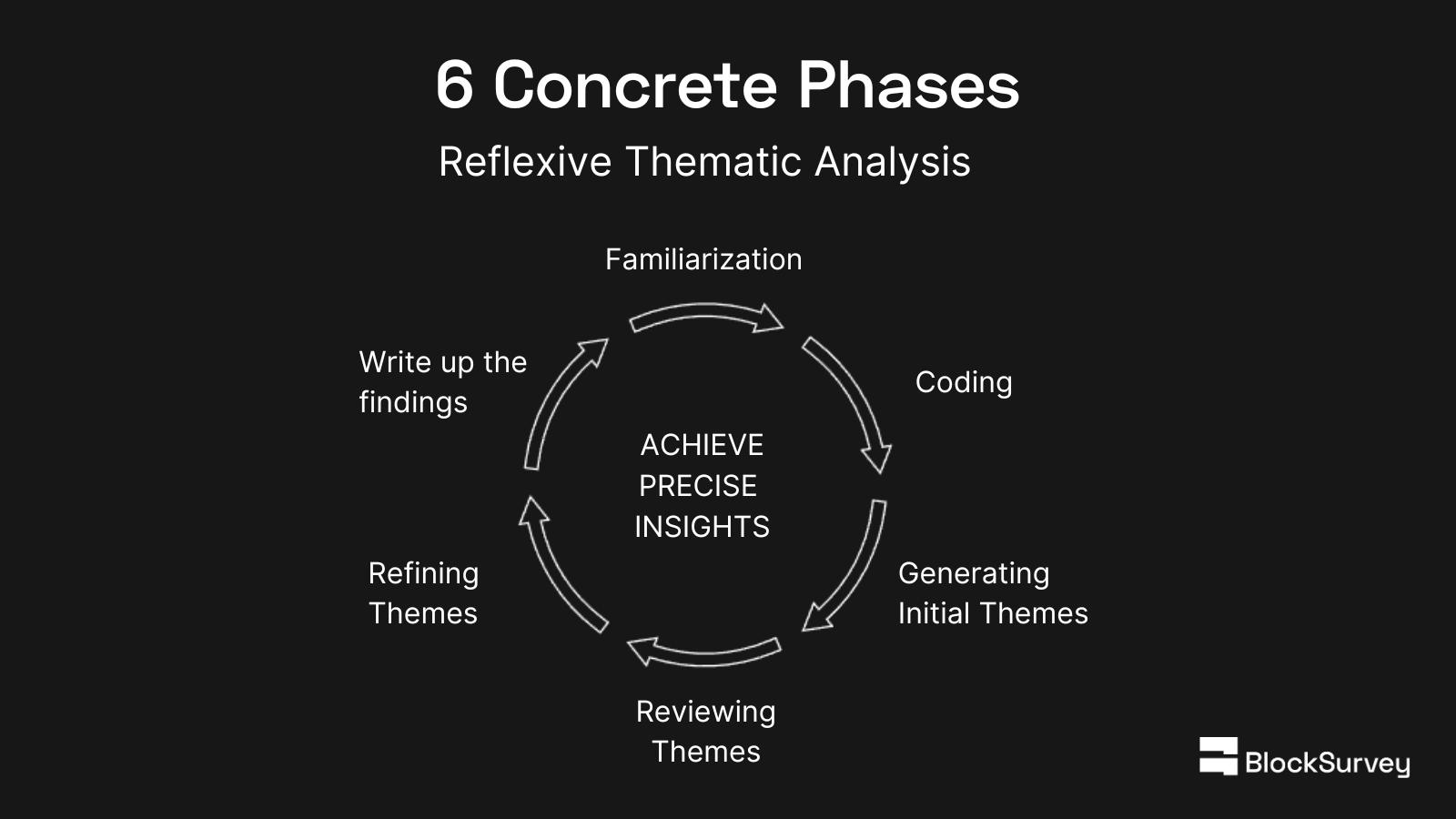Get insights.
Unlock value.
- 14-day free trial
- Set up in minutes
- No credit card required
Achieve Precise Insights with 6 Phases of Reflexive Thematic Analysis
Usually, Thematic Analysis is used to extract precise actionable insights from data transcripts. The role of the researcher & his viewpoints are seriously considered in a Reflexive (denotes the Researcher’s reflection) Thematic Analysis process. Braun & Clarke’s 6 phases of Reflexive Thematic Analysis are widely popular among researchers.
In this blog, I am humbled to explain to you the 6 phases of Reflexive Thematic Analysis, that are essential for achieving precise insights. The 6 phases are listed below.
- Familiarization
- Coding
- Generating Initial Themes
- Reviewing Themes
- Refining Themes
- Write up the findings

Develop a research intent before starting to perform RTA. Let’s look into each phase in more detail.
Phase-1: Familiarization
Read for familiarity
Do you have a large transcript to perform Thematic Analysis? Not sure how to familiarize yourself with the transcript? The best way is to read & reread the data. The transcript can represent survey responses, interviews, focus groups, or anything of that nature. In the familiarization phase, read your transcript as many times as you need to achieve a comprehensive understanding.
Ask Questions yourself
Start asking questions yourself & reflect on the subject. Below are a few questions that you can ask.
- What the transcript is trying to convey?
- What are the hidden meanings in the transcript?
- How should I approach the analysis?
Make Notes
Make sure to make notes of your thoughts. This is because your thoughts & ideas may vanish if you don’t make an effort to take notes. Try ZettleKasten way of making notes.
Once you have familiarized yourself with the transcript, you can move on to the next phase: Coding.
Phase-2: Coding
Segment Transcripts
It’s time to find out segments within the transcript. Identify segments that you find interesting. Extract segments that are relevant to each other. If you find any thought-provoking segment, make a note of that too.
Write Descriptions (Codes)
Start writing codes, which are brief descriptions of the segments you have identified within your transcript. These codes must provide insights about the segment. This process is called Coding.
Approach 360 degree
You can try multiple rounds of coding & different order of coding. In short, this phase is a 360-degree approach to segmenting your transcript & writing insightful codes.
In the familiarization phase, you get a comprehension of the transcript, in this coding phase, you are imparting your thoughts & ideas about each of the identified segments within the transcript.
Phase-3: Generating Initial Themes
Identify shared patterns
In this phase, you will start generating Themes based on the transcript. Themes are shared patterns that you find in the transcripts. The theme is not a single idea, but instead a shared idea. Generating themes requires careful analysis. It is not a passive process, but an exciting process. Discover as many themes as possible during this initial phase. Your familiarity with the transcript & the codes you have captured helps you generate themes with little difficulty.
Be Original
While generating themes, ask yourself “Does this theme capture something meaningful?”. One has to be original & inventive to create quality themes with the transcript. I reiterate, that generating themes requires the ingenuity of the researcher.
Phase-4: Reviewing the Themes
Look for Relevance
It does not end with generating Themes, it also involves reviewing the Themes you have created. The quality of your Theme is looked into in this phase. Find out how closely your Themes are aligned to the transcript data. If you think your Themes stand aloof, it's time to adjust the themes.
Make it a practice to check your themes and make necessary adjustments during this phase.
Here are a few questions you can ask yourself.
- Does the Theme feel rich?
- Does the Theme convey something important?
Remove Irrelevant Themes
If you discover a few Themes are no longer relevant, feel free to remove those Themes at this stage. Removing irrelevant themes is as important as generating Themes.
Phase-5: Refining the Themes
Capture what’s needed only
In this phase, we are called to create an abstract of the themes identified so far. Themes are refined at this stage by capturing the gist. You distill your thoughts and take an original approach to thinking about the identified Themes. Refine it again & again, till you are convinced with the quality.
Name the Theme
Start providing names to your Themes. Let’s say your Theme is talking about how customers (who lodge in a hotel) enjoy the hospitality of waiters, cleaners & receptionists. In this case, you can name your Theme “Staff Friendliness”. Remember, the name of your theme should be informative, concise & catchy.
Phase-6: Write up the findings
You can let others know about your findings in this sixth & last phase of your Thematic Analysis.
Connect with audience
Start with explaining to the audience how you approached this writing process. It is essential to identify and fill the knowledge gaps in this explorative phase.
The researcher's view should be clearly visible to the readers. So make sure to use the preferred first-person language. Explore for yourself what can be taken away from your Thematic Analysis. As a researcher, you must contribute to the existing body of knowledge.
Improvise Content for Readability
Allow sufficient time to edit your writing in order to capture precise insights. These insights, in turn, act as an important factor in your decision-making process.
Taking it forward
The 6 phases of Reflexive Thematic Analysis discussed in this write-up help you achieve precise insights for decision-making. Moving manually through these 6 phases can be a time-consuming process, but it is worth the effort.
On the other hand, AI-powered tools like BlockSurvey, Nvivo & MAXQDA can speed up the Thematic Analysis process. However, this AI approach cannot replace human acumen. Instead, an AI-powered approach under human supervision can do much good. It also increases the speed of analysis with reduced bias. I leave it to you to decide what works best for you.
BlockSurvey is constantly improving its AI Thematic Analysis capability. We are on the lookout for new & fresh ways to serve qualitative researchers. Try BlockSurvey’s Thematic Analysis to experience speed & accuracy.
Do let me know if you would like to see any specific TA feature in BlockSurvey. We are open to ideas. You can write to [email protected].
Achieve Precise Insights with 6 Phases of Reflexive Thematic Analysis FAQ
How detailed should my codes be in Phase-2: Coding?
Your codes should be descriptive enough to capture the essence of the segment, but concise enough to be manageable. The length can vary, but aim for clarity and avoid redundancy.
Can I combine or split themes during the Reviewing Themes phase?
Yes, you can refine your themes by combining those that overlap significantly or splitting a theme if it seems to encompass multiple distinct ideas. The goal is to have well-defined and coherent themes that accurately represent the data.
Is there a specific format for presenting the findings in the Write-up phase?
While there's no strict format, clarity and coherence are crucial. You might present themes individually with supporting data extracts, or weave them together in a narrative supported by evidence. Consider your audience and the best way to convey your findings.
How can AI tools like BlockSurvey be effectively used in the Reflexive Thematic Analysis process?
AI tools can assist in tasks like coding and identifying potential themes, saving you time and effort. However, they shouldn’t replace human judgment and critical analysis in reviewing themes, ensuring their relevance, and refining them for depth and clarity.
Get insights.
Unlock value.
- 14-day free trial
- Set up in minutes
- No credit card required

